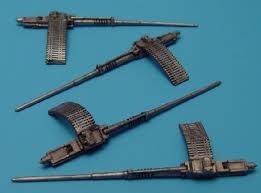Development
The Mk 12 was an advanced derivative of the wartime Hispano HS 404 that had been used on a variety of American and British fighter aircraft during World War II. It used a lighter projectile with a bigger charge for better muzzle velocity and higher rate of fire at the cost of hitting power. It entered U.S. Navy and U.S. Marine Corps service in the mid-1950s, replacing the Navy's earlier M3 cannon.
In service, the Mk 12 proved less than satisfactory. Although its muzzle velocity and rate of fire were acceptable, it was inaccurate and frequently unreliable. Pilots of the F-8 Crusader over North Vietnam, in particular, appreciated the presence of the cannon, but jams and stoppages were common, especially following hard dogfighting maneuvers.
Nevertheless, the Mk 12 was standard cannon armament on gun-armed Navy and Marine Corps fighters from the early 1950s to the early 1960s, including the F4D Skyray, F3H Demon, A-4 Skyhawk, F-8 Crusader and early Navy versions of the A-7 Corsair II. The Air Force version of the Corsair II, the A-7D, had a six-barreled M61A1 rotary 20mm cannon, as did the final Navy A-7E model.
SCREENSHOOT
SPECIFICATIONS
| Type | Autocannon |
|---|---|
| Place of origin | United States |
| Service history | |
| In service | 1950s–1960s |
| Used by | United States Navy |
| Wars | Vietnam War |
| Specifications | |
| Weight | 46.0 kg (101 lb) |
| | |
| Cartridge | 20×110mm USN |
| Caliber | 20 mm (0.787 in) |
| Action | Gas-operated reloading |
| Rate of fire | 1,000 rpm |
| Muzzle velocity | 1,010 m/s (3,300 ft/s) |
Labels: Aircraft mounted guns, Colt Mk 12 cannon


0 comments:
Post a Comment